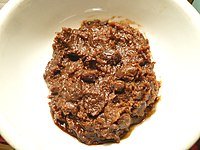
Photo from wikipedia
BACKGROUND Broad bean paste is a high-nitrogen and salt traditional Chinese condiment, which triggers biosynthesis of nitrogen hazards like biogenic amines (BA). Mechanisms of association and applied research of functional… Click to show full abstract
BACKGROUND Broad bean paste is a high-nitrogen and salt traditional Chinese condiment, which triggers biosynthesis of nitrogen hazards like biogenic amines (BA). Mechanisms of association and applied research of functional safety and community assembly within multiple-microbial fermentation are currently lacking. Here, bioaugmentation was performed based on the profiles of BA accumulation and microbial succession to evaluate the functional variation within broad bean paste fermentation. RESULTS Putrescine, spermine, and spermidine were the main BA during traditional broad bean paste fermentation. Staphylococcus, Streptococcus, Lactococcus, Lactobacillus, Leuconostoc, and Bacillus were the predominant bacteria, whereas Aspergillus and Zygosaccharomyces dominated in fungal species, and community structure shifted upon salt exposure. Bacillus contributed significantly (> 1%) to the amine oxidase gene family was uncovered via Phylogenetic Investigation of Communities by Reconstruction of Unobserved States (PICRUSt). Bacillus amyloliquefaciens 1-G6 and Bacillus licheniformis 2-B3 were screened to perform the bioaugmentation of broad bean paste, which achieved a 29% and 16% BA decrease, respectively. Interaction network analysis showed that Cronobacter and Lactobacillus were significantly negatively correlated with Bacillus (ρ = -0.829, ρ = -0.714, P < 0.05) in the B. amyloliquefaciens 1-G6 group, and Staphylococcus and Buttiauxella were inhibited by Bacillus (ρ = -0.657, ρ = -0.543, P < 0.05) in the B. licheniformis 2-B3 group. CONCLUSION The synergism of amine oxidase activity and microbial interactions led to the decline of BA. Thus, this study improves our understanding of the underlying mechanisms of microbial succession and functional variation to further facilitate the optimization of the fermented food industry. This article is protected by copyright. All rights reserved.
Journal Title: Journal of the science of food and agriculture
Year Published: 2022
Link to full text (if available)
Share on Social Media: Sign Up to like & get
recommendations!